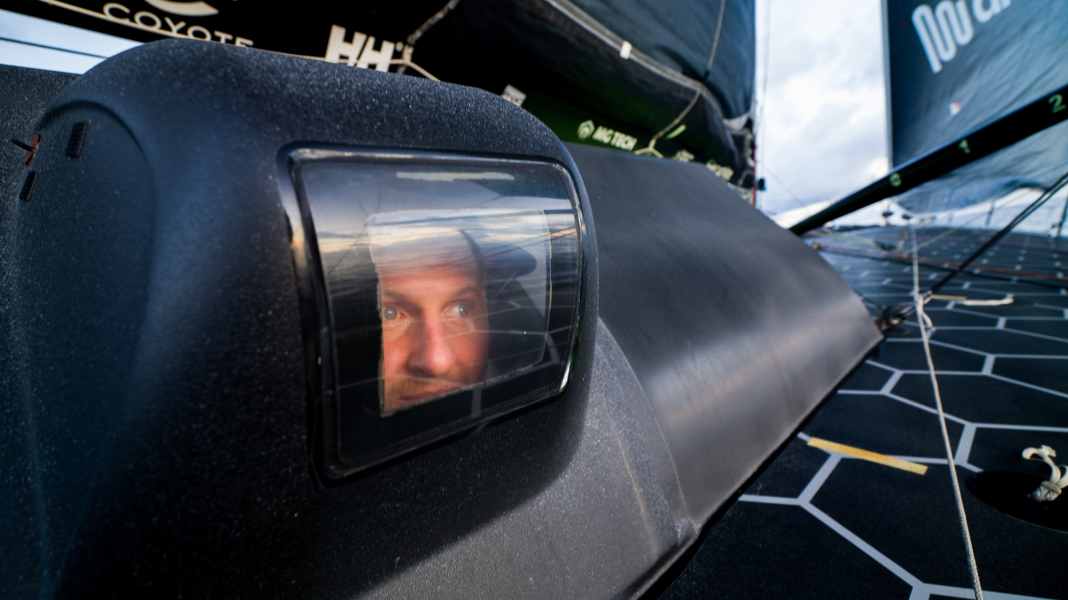
As an experienced Olympian, Stanjek sailed tactically differently to his competitors. Following the good old rule of "position yourself between the finish and your opponent", he defended his lead, simply sailed the shortest route through the Doldrums and, unlike all the other teams, refrained from heading west, where more wind was expected - but then could not be found. With a bit of weather luck, this gave him a solid lead.
Technically, however, Stanjek is actually an Open 60 rookie, at least offshore and compared to many of the skippers in the field who have various Vendée Globes or Volvo Ocean Races under their belts. That's why YACHT found the question of how he experiences one of the best Open 60s of the penultimate generation, Alex Thomson's 2016 "Hugo Boss", all the more exciting. And so YACHT was allowed to come on board "Guyot Environnement", and there was a tour of the boat. We were also on the boat before the start of the Route du Rhum at the end of 2022 and spoke to the French skipper Benjamin Dutreux.
The detailed video of the tour with Robert Stanjek on YACHTtv
What was clearly noticeable: after he had completed the very windy return passage from the Caribbean to the Mediterranean, shortly before the start, he really realised what was in store for him. Benjamin Dutreux got off the boat for the leg, Stanjek is skipper for the second leg to Cape Town. He spoke with great respect about the expected legs, repeatedly mentioning in his comments that an Open 60 is a technically highly complex boat. "It's crazy how many technical checks are necessary before a race, but also simply on a daily basis. That really surprised me!", he said frankly.
And you could tell that this was a sailor who is used to sailing boats with a lot of instinct. All the technology with high-tech autopilots, sensors and lots of tactical analysis software is important, but his gut feeling is just as important. "The main trim instrument for keeping the boat on the foils is actually the mainsheet. Then there's the angle of attack of the foils and the keel. The interplay between the lift of the foil and the keel fin lifts the boat out of the water."
And he also emphasises how different an Open 60 is from conventional fully-crewed racing boats in the cockpit: "All the halyards and control lines are very centralised here in the cockpit, which is different in the old Volvo boats. That requires a lot more ropes, we have more than three kilometres. And five winches are also really few for a ship like this; when we make big manoeuvres or change sails, it's sometimes a bit tight." You have to plan the manoeuvres extremely well in advance. This makes some manoeuvres slower than necessary, but that is the price you have to pay for sailing a boat that is actually designed for single-handed operation.
Standing in the cockpit, he also explains that it is important for an active regatta sailor from small boats to rethink. "The cockpit here is of course blatantly shielded. You can hardly see anything, especially at night or when the water flies over the deck. You can look into the sails with a torch, but then you only get a rough idea. The ship is mainly sailed by numbers. It is mainly steered using the autopilot. In fast reaching and foil conditions, it's impossible to steer the boat as a human, there's too much pressure on it."
You can tell that Stanjek has had an enormously steep learning curve, growing into an experienced Open 60 skipper in this race in no time at all. All the more brilliant is how the German is sailing with his team, "Guyot Environnement" sails tactically consistent and compensates very effectively for the slower boat in competition with four somewhat faster newbuilds.
But you can also tell that he is happy to be travelling with a crew. When asked whether he can imagine sailing such a boat single-handed after the Ocean Race, he immediately replies in the negative. You can always tell that he has a healthy respect for the technically very complex boats, which are indeed a Herculean task to operate alone. In this respect, the round with Robert Stanjek about the boat is more exciting than with Boris Herrmann: for the latter, an Imoca is the most natural thing in the world, for Stanjek it is still so fresh that it brings across the perspective of the normal sailor very vividly.

